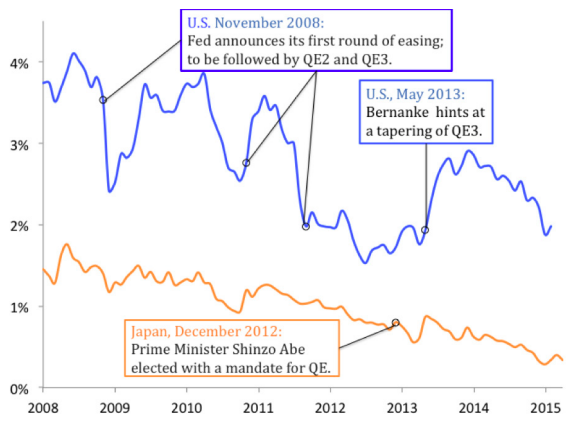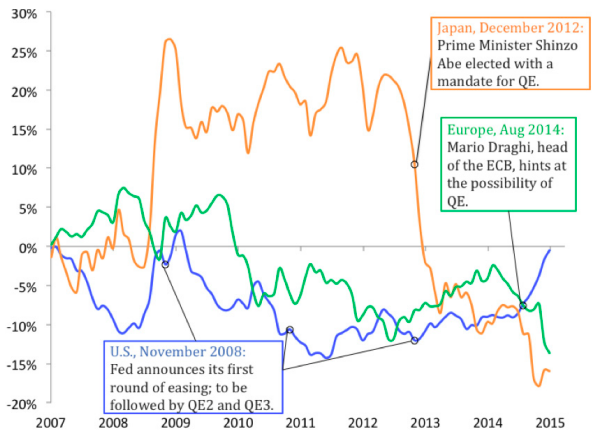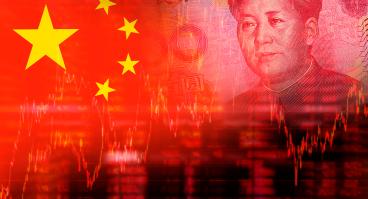The Unfavorable Economics of Currency Manipulation Chapters in Trade Agreements

Table of Contents
Author(s)
Russell Green
Former FellowShare this Publication
- Download PDF
- Print This Publication
- Cite This Publication Copy Citation
Green, Russell A. 2015. The Unfavorable Economics of Currency Manipulation Chapters in Trade Agreements. Issue Brief no. 04.27.15. Rice University’s Baker Institute for Public Policy, Houston, Texas.
Executive Summary
As Congress resumes work this spring on a bill granting Trade Promotion Authority (TPA) to President Obama for completion of the Trans-Pacific Partnership trade pact, many members have sought inclusion of a chapter on currency manipulation. Currency manipulation is a legitimate concern. However, countermeasures require clear, objective identification of currency manipulation. Both the IMF and the US Treasury Department have mandates to identify currency manipulation, yet neither has done so in the past 20 years. If it can be done, why has it not happened more often?
This issue brief reviews the difficulties of operationalizing a currency manipulation chapter. It first demonstrates that domestic policies and exchange rate policy can rarely be distinguished. It reviews the official IMF criteria for currency manipulation to highlight the degree of discretionary interpretation necessary for a determination. It argues that the difficulty of identifying currency manipulation suggests serious political obstacles to implementation.
Background
After the collapse of the Breton Woods system of fixed exchange rates, members of the IMF adopted new rules for exchange rate policies. Included in these new rules was a stipulation that “each member shall… avoid manipulating exchange rates…to gain an unfair competitive advantage over other members.” IMF surveillance of compliance with this language, included in Article IV of the IMF’s Articles of Agreement, became the first mechanism in place to prevent currency manipulation.
In its 2007 Decision on Bilateral Surveillance over Members’ Policies, the IMF clarified the concept of manipulation by breaking it into two parts: fundamental misalignment of the exchange rate and intent to manipulate the exchange rate for the purposes of gaining an unfair advantage in international trade. Misalignment alone is fairly common and can occur for many reasons. Besides policies designed to gain unfair advantage, the pursuit of legitimate domestic economic policy goals affect exchange rates, as do market imperfections and policies in other countries. For this reason, a judgment of the policy intent becomes crucial.
The IMF has rarely used its mandate to exercise firm surveillance of Article IV, having never found a country in violation of Article IV and having conducted a special consultation over a potential violation only twice.1 Further, worried that IMF surveillance had yielded little result, Congress enacted a law in 1988 requiring the Treasury to monitor currency manipulation in a semiannual report. Since the inception of the law, only four instances of currency manipulation have been cited.2
Domestic Policy or Exchange Rate Policy
Identifying the intent of government action becomes extremely difficult because domestic policy and exchange rate policy are intrinsically intertwined. With few exceptions, attempts to distinguish between the two are fruitless. This section explains the link between domestic and exchange rate policy using textbook international economics and supports it with a discussion of what happens in practice.3
Basic Economic Theory
Beginning with monetary policy, the mechanics of how a country’s central bank manipulates money supply are central to understanding how it influences the exchange rate. In order to increase the money supply, a central bank purchases securities. The central bank’s payment for the securities constitutes new money in the economy, raising the amount of base money.
A central bank can purchase essentially two types of securities. It can buy domestic securities, like domestic government bonds, in a process known as open market operations (OMO). It can also buy foreign securities, like foreign government bonds. It first buys foreign currency using new domestic currency, then invests it in foreign securities. This process is known as foreign exchange (FX) intervention. In either case, the money supply increases.
The effect is a decrease in domestic interest rates. OMO has this effect directly from the central bank’s purchase of bonds, which pushes the price higher and yield lower. In FX intervention, the seller of the foreign currency now has US dollars that are either deposited in a US bank or invested in US securities.4 As demand for dollar bank deposits and securities rises, banks and security owners can attract the same amount of money at lower interest rates.
Likewise, both types of transactions have the same impact on exchange rates. Lower interest rates means the domestic currency is less valuable. Money flows out of the country seeking higher interest rates. The selling of domestic currency in exchange for foreign currency causes depreciation.
The key point is that the effects of OMO and FX intervention are the same. Whether a central bank purchases domestic securities or foreign securities makes no difference on the end result. Both monetary policy paths produce larger monetary bases, lower interest rates, and depreciation of the domestic currency.
Most central banks with major currencies sterilize their intervention. That is, they engage in domestic OMO in the opposite direction of the FX intervention, so the impact on the domestic money supply is neutralized. In practice, sterilized FX intervention can still impact the exchange rate, but what evidence has been found points to only short-term impacts among countries with open capital accounts (free flow of capital).5 Since trade patterns will not be affected substantially by exchange rate fluctuations that last a single week or less, sterilized intervention can be ignored for the purpose of evaluating currency manipulation among countries with an open capital account.
Similarly to monetary policy, ordinary domestic fiscal policy impacts the exchange rate. Fiscal policy involves changing the government deficit and therefore total national saving. Basic macroeconomics suggests that a fiscal consolidation that raises domestic saving, for instance, causes the domestic interest rate to fall in a large open economy.6 The lower domestic interest causes capital outflow, subsequently depreciating the domestic currency. Fiscal consolidation, therefore, has a similar effect to the central bank’s stimulus policy described above. Accordingly, expanding fiscal deficits tend to cause appreciation, similar to the impact of money supply contraction.
What Happens in Practice?
Real world examples illustrate the tight connection between domestic and external policies. For instance, the quantitative easing (QE) programs in the United States and Japan directly show the effect of monetary policy on FX rates in practice. Furthermore, a multitude of countries have joined the likes of Australia, China, and Singapore in lowering their rates recently on the backs of weak economic performance, low price levels, and sluggish GDP growth, with predictable impacts on their exchange rates.
Figure 1 — Ten-year Government Bond Yields in the United States and Japan

After the Lehman Brothers collapse of 2008, the US Federal Reserve underwent three rounds of QE. With short-term rates very close to zero, the QE programs targeted longer-term interest rates. Over the course of the three rounds, long-term bond yields dropped over 1.5 percentage points. Over the same period, the real trade-weighted dollar dropped by 10 percent.
A similar story can be told in Japan. In December 2012 Shinzo Abe became prime minister with a mandate to enact QE, and his election was enough to move markets in anticipation. By April of 2013, the Bank of Japan announced its QE program and expanded it in October of 2014. This aggressive domestic monetary policy had immediate effects on Japan’s economy and its various financial markets. From the date of election until April 2015, 10-year government bond yields—already very low—fell by 0.5 percentage points to only 0.3 percent. As expected, the QE policies also led to a dramatic weakening of the yen, with the real trade-weighted yen losing 25 percent of its value through April of this year.
Figure 2 — Trade-weighted Real Exchange Rates for the Dollar, Yen, and Euro (Percent Change From January 2017)

More than 20 countries have eased monetary policy in 2015 because of weakness in their economies and falling prices. Of the 14 that lowered the central banks’ policy interest rate in the six months through February, 11 saw their real, trade-weighted exchange rates weaken.7 The remaining included China, which closely tracks the dollar, and Switzerland, which lowered rates to fight appreciation pressure. China, Switzerland, and Singapore, which lowered rates in March, merit further attention.
Singapore makes its exchange rate its main monetary policy tool, rather than interest rates. It exemplifies the impact of FX intervention on domestic rates, as Singapore has chosen FX stability over interest rate stability. That is true of any open economy with a pegged exchange rate. Even though the central bank constantly engages in FX intervention to maintain the peg, it is not deemed currency manipulation per se. So long as capital can flow freely, as in Singapore’s case, and markets adjust, domestic price movement should help maintain a stable real exchange rate.
China also manages its exchange rate heavily, but because it does not have an open capital account, interest rates are much less responsive to FX intervention. Policies like sterilized intervention are much easier to implement. The domestic-external linkage still exists, though, in a mitigated manner. For instance, the People’s Bank of China (PBOC) recently cut the Reserve Ratio Requirement by 50 basis points, an action similar to an interest rate cut. A number of such monetary easing moves have reduced the desirability of Chinese assets, helping to bring capital flows into balance. As a result, for the past year PBOC intervention in foreign exchange markets has fallen dramatically. The PBOC allows the market to determine the value of the renminbi to a much greater degree than in the past.
Finally, Switzerland provides a good example of the ineffectiveness of sterilized intervention for long-term currency manipulation in an open economy. When Lehman Brothers collapsed, the Swiss franc appreciated as a safe-haven currency. The Swiss National Bank (SNB) began to intervene heavily to prevent further appreciation in the fall of 2008 through the first half of 2009. Importantly, it allowed the money supply to increase, so effectively the intervention was not sterilized. The intervention succeeded in stabilizing the franc. Then in the spring of 2010, capital inflows rose again and the SNB intervened heavily to prevent appreciation. The intervention effectively was sterilized, as money supply barely changed over the period. This time the intervention did not succeed, as the franc appreciated 5 percent. In part because of the difficulty of sterilization, in January 2015 the SNB found its intervention too disruptive of its domestic monetary policy goals and abandoned its defense of the franc.
Turning to fiscal policy, the evidence on how it impacts exchange rates is messy. Because of the confluence of other macroeconomic trends and monetary policy, it is often hard to disentangle the impact of fiscal policy from other factors. Careful research by John Bluedorn and Daniel Leigh at the IMF isolated this effect and finds strong evidence supporting the theory that real exchange rates depreciate with fiscal consolidation. Bluedorn and Leigh find that a 1 percent of GDP decline in the fiscal deficit causes a 1.5 percent decline in the real effective exchange rate (REER) in the first year.8
Finland provides a rare, relatively clean example of fiscal consolidation. The Finnish government began a fiscal consolidation program in 1993, following a painful recession. This led Finland’s fiscal balance to improve by 14 percentage points to a 7 percent of GDP surplus, including a decline in public debt. Depreciation of the markka followed, from a REER high of 117 to a low of 97.9
We can find many examples of the opposite effect, i.e., fiscal expansion programs contributing to FX strength. In the early 1980s the United States experienced currency strengthening after the Reagan administration’s fiscal expansion. In the early 1990s Germany engaged in high expenditures after reunification that strengthened the Deutsche mark. In both countries, high interest rates also contributed to the currency strengthening.
Criteria for Currency Manipulation: Open to Interpretation
A chapter on currency manipulation presumably would use language nearly identical to the existing guidelines adopted by the IMF in its 2007 decision, as many past congressional proposals have.10 It would therefore face the same challenge of determining misalignment and intent. Most of the IMF’s criteria leave room for argument, which is a major reason neither the IMF nor the US Treasury Department have identified currency manipulation in recent years.
The most important factor for determining currency manipulation is to establish “fundamental exchange rate misalignment.” Assessing the proper valuation of a currency based on fundamentals poses a stiff challenge to economists, with many metrics and constant evolution of thinking. Since 2013 the IMF has used three different indicators of exchange rate misalignment, two statistical and the third judgmental.11 This measure improves upon the previous methodology developed only five years prior. The multiplicity of measures and their frequent revisal leaves plenty of room for debate. Even when all three of the current IMF indicators point in the same direction, countries disagree with IMF assessments.12
Identifying misalignment leads to the next, even messier question of intent. Because domestic policies can move exchange rates, countries pursuing legitimate domestic goals may invite accusations of currency manipulation. Indeed, this is one major concern raised by Janet Yellen, chair of the US Federal Reserve, in opposing the idea of a currency chapter. Of course, the opposite is also possible. A country intending to manipulate its currency for unfair trade advantage may use domestic policy levers to do so, obscuring its intent. Either case leads to a debate about the legitimacy of purported domestic objectives. No precedent exists for resolving such a debate in an objective fashion. IMF policy is to give the benefit of the doubt to the country enacting the policy.
Even misalignment resulting from active use of foreign exchange policy can be legitimate. The IMF considers maintaining a pegged exchange rate via active intervention, as in the case of Singapore mentioned earlier, a legitimate monetary policy choice. In theory domestic prices will adjust to maintain a stable real exchange rate. To help differentiate between legitimate currency policy and prohibited policies, the IMF’s 2007 decision includes four criteria that might suggest manipulation:
- protracted large-scale FX intervention in one direction
- excessive and prolonged accumulation of foreign assets for balance of payments purposes
- changing current account or capital account restrictions for balance of payments purposes
- monetary and other financial policies that abnormally affect capital flows for balance of payments purposes
The first criterion is the only one not restricted to action taken “for balance of payments purposes” and is therefore the only aspect of identifying manipulation that is relatively clear-cut. Yet it, too, raises questions of interpretation. A country with a fixed exchange rate facing protracted, large-scale capital inflows would need equivalently protracted and large-scale intervention to maintain its peg. For a variety of reasons, domestic prices may not rise to stabilize the real exchange rate. Yet the country may need to maintain the peg, for instance to preserve trade and financial stability or to prevent deflation. The country may then attract unwarranted accusations of currency manipulation.
The second criterion has problems as well. Countries with major natural resource booms may fear the “resource curse” caused when repatriation of massive revenue from resource exports causes the exchange rate to appreciate. Other export industries may become uncompetitive and die off. One method to combat this problem—a method the IMF endorses—is to accumulate foreign assets in a sovereign wealth fund (SWF).13 Norway, most Gulf countries and Brunei—one of the 12 countries negotiating the TPP—have SWFs. An SWF helps a country avoid repatriation of export proceeds, mitigating appreciation. Another way to describe the use of an SWF might be: “prolonged accumulation of foreign assets for balance of payments purposes.”
The third criterion is not problematic, but it only applies to changes in policies. It does not apply to countries like China and India that already have substantial capital controls. The final criterion is so vague as to be practically useless. Alternatively it could create tremendous heartburn for countries using monetary and financial policy to pursue domestic goals, generating conflict over whether the ultimate goal is promoting exports.
In sum, no aspect of the process of identifying currency manipulation is clear. Most descriptions of a currency chapter overlook this difficulty.14 Only in the most egregious cases would a determination of currency manipulation prevail. China’s exchange rate policies in the mid-2000s provide a good example. Until 2005 China had a peg to the US dollar, with very limited flexibility allowed in the subsequent two years. China ran large current account surpluses and accumulated international reserves at a rate of $200 billion per year. It also operated current and capital account restrictions that blocked the normal forces that might equilibrate China’s real exchange rate. Chinese officials admitted that they used exchange rate policies to create export-focused factory jobs for its growing workforce, so intent was not questionable.15 In this case, currency manipulation was clear. Even so, no formal accusation of currency manipulation was made.
Conclusion
Given the difficulty determining currency manipulation, a treaty could never feasibly function by allowing individual treaty members to make their own determinations. First, the malleability of the concept exposes the signatories to sanctions against legitimate domestic policies. Second, even when the case is solid, unilateral determination is too easily pilloried as self-interested. This is one reason the US Treasury has hesitated to identify currency manipulation independent of an IMF determination.
The IMF is the only organization with both the expertise and objectivity to play this role. Yet it is clearly loathe to do so, as exemplified by its failure to call out China’s egregious exchange rate policies in the mid-2000s. Former IMF Managing Director Rodrigo de Rato famously said he did not believe the IMF should play the role of global “umpire.” Instead, the IMF has developed complex layers of analysis to determine currency manipulation, which is appropriate given the nature of the concept. But each layer provides an opportunity to legitimize questionable policies. Leaving the job to the IMF essentially ensures it will not happen.
Congress remains adamant about the inclusion of currency manipulation rules in the TPP agreement. It cannot proceed without clarifying how to identify currency manipulation. At present, the choice lies between determination by signatories—a clear poison pill for the agreement—or determination by the IMF, which renders the measure moot. A workable alternative has evaded economists and policymakers for more than 30 years. What solution does Congress have in mind?
Endnotes
1. Sweden in 1982 and South Korea in 1987. Morris Goldstein, “Currency Manipulation and Enforcing the Rules of the International Monetary System,” in Reforming the IMF for the 21st Century, ed. Edwin M. Truman, Special Report 19 (Washington, DC: Institute for International Economics, 2006).
2. Taiwan and South Korea in 1988, and China and Taiwan in 1992. GAO, International Trade: Treasury Assessments Have Not Found Currency Manipulation, but Concerns about Exchange Rates Continue (Washington, DC: US Government Accountability Office, April 2005), http://www.gao.gov/new.items/d05351.pdf.
3. See, for instance, Paul R. Krugman, Maurice Obstfeld, and Marc Melitz, International Economics: Theory and Policy, 10th edition (Boston: Prentice Hall, 2014).
4. Even if a foreign resident uses the dollars for something overseas, such as a Eurodollar deposit, the overseas bank does not hold the dollars overseas. Rather, it holds the dollars in an escrow account with a US custodian bank. Even if they purchase another US security instead of making a bank deposit, the seller of that security now has money to put in a bank. In the end, the dollars always come back into the US banking system.
5. See also Mark P. Taylor and Lucio Sarno, “Official Intervention in the Foreign Exchange Market: Is It Effective And, If So, How Does It Work?,” Journal of Economic Literature 39, no. 3 (2001): 839–68.
6. This assumes private savings does not adjust to compensate for a change in the fiscal deficit. Such adjustments do occasionally occur. B. Douglas Bernheim, Ricardian Equivalence: An Evaluation of Theory and Evidence, NBER Working Paper (March 1988), http://www.nber.org/papers/w2330.
7. The time period was dictated by availability of real trade-weighted exchange rate data.
8. John Bluedorn and Daniel Leigh, “Revisiting the Twin Deficits Hypothesis: The Effect of Fiscal Consolidation on the Current Account,” IMF Economic Review 59, no. 4 (November 2011): 582–602, https://www.imf.org/external/np/seminars/eng/2010/eui/pdf/BL.pdf. See also Marialuz Moreno Badia and Alex Segura-Ubiergo, “Real Exchange Rate Appreciation in Emerging Markets: Can Fiscal Policy Help?, ” IMF Working Paper (International Monetary Fund, 2014), http://www.imf.org/external/pubs/cat/longres.aspx?sk=41196.
9. HM Treasury, International Examples of Spending Consolidations, September 17, 2009, https://www.gov.uk/government/uploads/system/uploads/attachment_data/file/220923/foi_fiscal_ consolidation_010210.pdf.
10. For example, Currency Exchange Rate Oversight Reform Act of 2013 (S 1114. 113th Cong., 1st sess, June 7, 2013).
11. Steven Phillips, Luis Catão, and Luca Antonio Ricci, “The External Balance Assessment (EBA) Methodology,” IMF Working Paper 13/272 (Washington, D.C.: International Monetary Fund, 2013), http://www.imf.org/external/pubs/ft/wp/2013/wp13272.pdf.
12. Many countries still do not fully agree with this metric, as exemplified in the Executive Board discussion of the 2014 IMF Triennial Surveillance Review. http://www.imf.org/external/np/sec/pr/2014/pr14454.htm.
13. IMF, Sovereign Asset-Liability Management: Guidance For Resource-Rich Economies (Washington, DC: International Monetary Fund, June 10, 2014), http://www.imf.org/external/np/pp/eng/2014/061014.pdf.
14. See, for instance, Jared Bernstein, “How to Stop Currency Manipulation,” The New York Times, January 9, 2015.
15. IMF, People’s Republic of China: 2004 Article IV Consultation, IMF Country Report (Washington, DC: International Monetary Fund, November 2004) para. 21; IMF, People’s Republic of China: 2006 Article IV Consultation, IMF Country Report (Washington, DC: International Monetary Fund, October 2006) para. 27.
This material may be quoted or reproduced without prior permission, provided appropriate credit is given to the author and Rice University’s Baker Institute for Public Policy. The views expressed herein are those of the individual author(s), and do not necessarily represent the views of Rice University’s Baker Institute for Public Policy.


